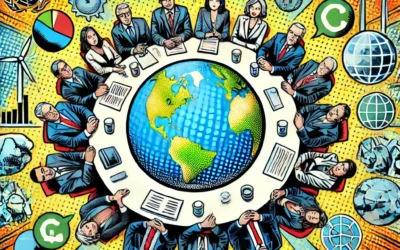Material Projectivity: How to Use Resources More Efficiently and Effectively
Material productivity is the ratio of economic output (in terms of GDP) to material consumption (in terms of DMC). It measures how well the economy uses natural resources to generate value and wealth. According to the OECD Material Projectivity Indicator, the average material productivity in the OECD countries was 2.1 USD/kg in 2019, with a wide variation across countries. In this article, we will explore the factors, impacts, and policies of material productivity.
Factors of Material Projectivity
Material productivity depends on various factors, such as the type, quality, and quantity of the materials used, the technology, innovation, and efficiency of the production processes, the demand, consumption, and preferences of the consumers, and the policy, regulation, and governance of the resource management. Some of the main factors are:
Material mix: The material mix refers to the composition and diversity of the materials used in the economy. Different materials have different environmental impacts and economic values, depending on their origin, availability, and characteristics. For example, renewable materials, such as biomass, have lower environmental impacts than non-renewable materials, such as fossil fuels, but they may also have lower economic values. A more balanced and diversified material mix can improve material productivity by reducing the dependence and vulnerability on certain materials, and by increasing the opportunities and options for substitution and complementarity.
Material efficiency: Material efficiency refers to the optimal and rational use of the materials in the economy. It aims to minimize the material inputs and outputs, and to maximize the material performance and utility. Material efficiency can be achieved by improving the design, quality, and durability of the products, by extending the life and use of the products, by recovering and recycling the materials and components of the products, and by reducing the waste and emissions generated by the products.
Material demand: Material demand refers to the quantity and quality of the materials required by the economy. It is influenced by the population, income, and consumption patterns of the society, as well as by the economic structure and activity of the economy. Material demand can be reduced by changing the behavior and preferences of the consumers and the producers, by promoting and supporting the voluntary and social initiatives and movements that advocate for the reduction of material consumption, such as the sharing economy, the minimalist lifestyle, and the zero waste movement, and by implementing and enforcing the policies and regulations that discourage or limit the use of the materials, such as taxes, bans, or quotas.
Impacts of Material Projectivity
Material productivity has various impacts on the environment, the economy, and the society. Some of the main impacts are:
Environmental impacts: Material productivity can reduce the environmental impacts of the economy, such as greenhouse gas emissions, resource depletion and degradation, and waste generation and disposal. By doing so, material can contribute to the mitigation of climate change, the improvement of air and water quality, the conservation of biodiversity and ecosystems, and the enhancement of human health and well-being.
Economic impacts: Material productivity can increase the economic value and wealth of the economy, by creating and sustaining the markets, industries, and jobs for the production, consumption, and disposal of the materials and the products. Material productivity can also improve the efficiency and equity of the economy, by reducing the costs and risks associated with the use and management of the materials, by increasing the competitiveness and innovation of the economy, and by improving the distribution and allocation of the resources and the benefits.
Social impacts: Material productivity can improve the social welfare and justice of the society, by providing and improving the public services, opportunities, and rights for the people who use and depend on the materials and the products. Material productivity can also reduce the social conflicts and inequalities associated with the materials, such as the access, ownership, and control of the resources, and the responsibility, accountability, and liability for the impacts and outcomes of the use and management of the resources.
Policies of Material Projectivity
Material productivity can be enhanced by adopting and promoting the policies and strategies that aim to improve the use and management of the materials in the economy. Some of the main policies are:
Circular economy: Circular economy is a concept and a practice that aims to minimize the use of natural resources and maximize their value and utility. It is based on the principles of reduce, reuse, and recycle, and it involves the design, production, consumption, and disposal of the products and services in a way that preserves and regenerates the natural capital and resources, and reduces the waste and emissions. Circular economy can improve material productivity by extending the life and use of the materials and the products, by recovering and transforming the materials and components of the products, and by creating new markets and jobs for the circular products and services.
Green growth: Green growth is a concept and a practice that aims to achieve economic growth and development while ensuring environmental sustainability and social inclusiveness. It is based on the integration and alignment of the environmental, economic, and social objectives and interests, and it involves the innovation, investment, and governance of the green sectors and solutions. Green growth can improve material productivity by stimulating and enhancing the innovation and competitiveness in the green sectors, by creating and sustaining the markets and industries for the green products and services, and by improving the efficiency and equity of the use and management of the materials and the products.
Sustainable development: Sustainable development is a concept and a practice that aims to meet the needs and aspirations of the present generation without compromising the ability and opportunity of the future generations to meet their own needs and aspirations. It is based on the balance and harmony of the environmental, economic, and social dimensions of human well-being, and it involves the participation and empowerment of the people and the stakeholders in the decision-making and policy-making processes. Sustainable development can improve material productivity by providing and improving the public services, opportunities, and rights for the people who use and depend on the materials and the products, by reducing the social costs and inequalities associated with the materials, and by enhancing the public awareness and participation in the material issues.
Conclusion
Material productivity is the ratio of economic output (in terms of GDP) to material consumption (in terms of DMC). It measures how well the economy uses natural resources to generate value and wealth.
Material productivity depends on various factors, such as the material mix, material efficiency, and material demand. Material productivity has various impacts on the environment, the economy, and the society, such as environmental benefits, economic benefits, and social benefits.
Material productivity can be enhanced by adopting and promoting the policies and strategies that aim to improve the use and management of the materials in the economy, such as circular economy, green growth, and sustainable development. Material productivity is a key indicator of the human-environment relationship, and can contribute to the goals and targets of climate policy and sustainable development.






